|
Created
2013.8.28
Updated 2021.2.18
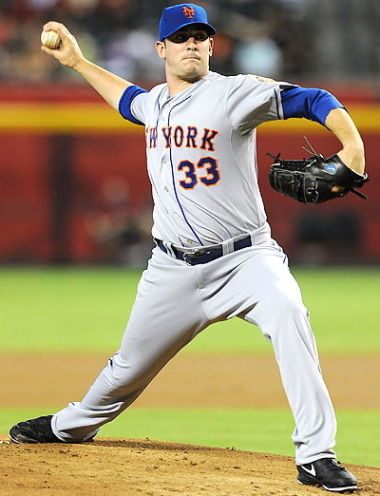 Matt Harvey's pitching mechanics are flawed and are putting his career
at risk; he needs to start saving his money because, if he doesn't
change anything — and, at this point, likely even if he does — the
end of his career is right around the corner. Matt Harvey's pitching mechanics are flawed and are putting his career
at risk; he needs to start saving his money because, if he doesn't
change anything — and, at this point, likely even if he does — the
end of his career is right around the corner.
That should be obvious, given the predictability of his
performance issues and injury problems.
The problem with Matt Harvey's pitching mechanics starts with how he follows the common cue to...
That leads to a problem I call the...
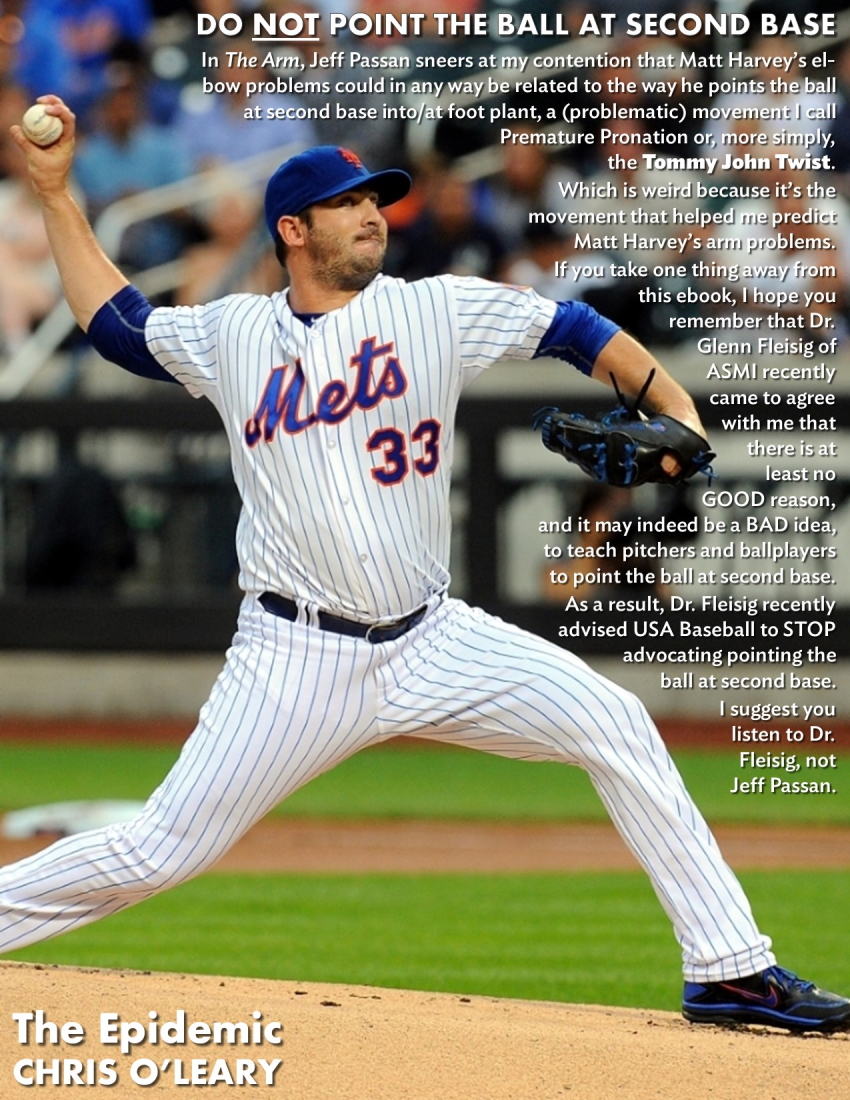
Matt Harvey
Pointing the Ball at Second Base
CLICK TO ENLARGE
...which is problematic because it creates a
Timing problem.
Matt Harvey's Pitching Mechanics
What's so tragic about Matt Harvey's injury problems is they
were completely predictable.
And were predicted.
So what happened to Matt Harvey?
Why Tweets?
If you doubt what I said, and when, I've put together two
pieces that explain this in the form of tweets.
And, remember, tweets are...
- Time-Stamped.
- Not Editable.
My Experience
Generally, when I write about the pitching mechanics of pitchers, I have no connection to them; I have never met
them and have never even talked to them.
That's not the
case when it comes to Matt Harvey.
In late 2007 I was asked by Ed Harvey to analyze Matt's
pitching mechanics. He wanted me to make sure there was no sign of the
Inverted W or other issues.
While Matt Harvey's pitching mechanics were relatively clean in 2007, by 2012 something had changed;
something that allowed me to predict Matt Harvey's elbow problems
months in advance. In a conversation with Steve Czaban and in
a follow-up e-mail to a 5.13.13
conversation with a writer for New York Magazine who was writing
a piece about why Matt Harvey was so successful, I expressed
concern about something I saw in Matt Harvey's pitching
mechanics...
Here's a picture of Matt Harvey that shows the timing
problem that I am talking about and that concerns me.
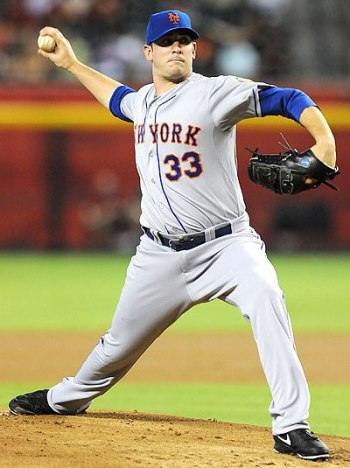
Matt Harvey
Given that his front foot is down, his pitching arm should be
more vertical.
However, while Steve Czaban was interested in my concerns, my
comments didn't make it into the New York Magazine piece.
What Mets fans should find troubling is that, while I have
seen signs of progress in Matt Harvey's pitching mechanics at
times, of late that progress seems to have
disappeared.
It looks like Matt Harvey is back to the pitching mechanics
that got his elbow in 2013 and the underlying problems with his mechanics...
All of that explains why I have continued to express concerns
about Matt Harvey's pitching mechanics and was talking about
Thoracic Outlet Syndrome (TOS) back in March and April.
A Concerned Father
In late 2007, as Matt Harvey was getting ready for his freshman
baseball season at North Carolina, I was contacted by his dad, Ed. Ed had come
across my work on the
Inverted W
and thought it had some merit — I believe because he had been told
to look into teaching the Inverted W to Matt, researched it, and decided not to — and asked
me to look at Matt's pitching mechanics and see if I saw
anything that looked problematic.
I told him that I liked what I saw.
There was no sign of the Inverted W in Matt's arm action and,
just as importantly, there was no sign of a general timing problem.
While Matt did have a similar arm swing and got to the same T
Position as Mark Prior — with his arms extended out to his
sides as he broke his hands — Matt didn't come out of that
position by lifting with his elbows as Prior did. Instead, he
did what comes naturally to most people and kept his elbows just
below the level of his shoulders as he externally rotated his
pitching arm and
scap
loaded.
Yes his glove side wasn't perfect and his scap load was a bit
extreme as a result, but his mechanics were well within the range of what you see in long-lived
pitchers. His elbows stayed below the level of his shoulders
and he had never had any problems with the front of his
shoulder.
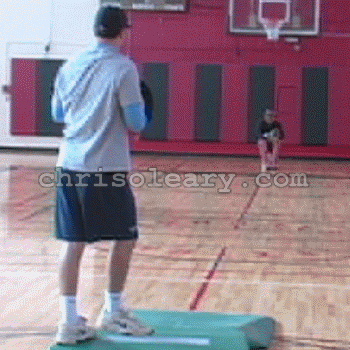
Matt Harvey
December 2007
In the clips above and below, notice how Matt's arm gets up
and into the Ready Position just before his front foot plants
and his shoulders start to rotate. As he goes into foot plant,
you can see his pitching arm externally rotate 90 degrees so
that it gets to a good position.
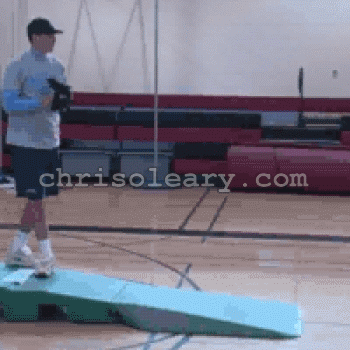
Matt Harvey
December 2007
What Matt exhibited was an arm action that was generally
quite similar to the arm actions of Roy Oswalt and Justin
Verlander. Matt also had the nice pelvic and shoulder tilt, and
high front shoulder into foot plant, that you see in Justin
Verlander. The only thing I didn't like about Matt's delivery
was his glove-side action; how, and how much, it got behind his
shoulders during his delivery.
In September 2012 the Mets came through St. Louis. I went
down to the stadium to watch
Andres Torres play and Matt Harvey pitch.
I was excited because I
assumed I was going to get some footage of the next Justin
Verlander. Footage that I could show to
young pitchers and use to teach them what they should do.
What I got was something else.
A different Matt Harvey than I had seen coming out of high
school.
Where before Matt did a good job of getting his pitching arm
up on time, what I saw was a pitching arm that stalled; that
started to rotate up and then stalled.

Matt Harvey
September 2012
The result was that his arm was late and out of position at
the moment his front foot planted and his shoulders started to
turn.

Matt Harvey
December 2007
Where before Matt Harvey...
- Had a smooth, natural arm swing.
- Moved out with tilted hips and a raised front
shoulder.
- Pointed the ball at Third Base.
...what I now saw was a pitcher whose arm struggled to get up to
the Ready Position and was late as a result.

Matt Harvey
September 2012
The new and "improved" Matt Harvey...
- Lifted with his elbows.
- Looked like he was trying to keep his fingers on top of the ball as long as possible.
- Moved out with largely level shoulders.
- Appeared to be trying to make and hold the
Power T into foot plant.
...and, in my opinion, most importantly...
The problem is, that by pointing the ball
at second base, keeping his fingers on top of the ball, and/or whatever cue he used, Matt Harvey created
tension in his pitching arm. This tension likely led to a quick
velocity boost, but it did so by compromising the thing
that is the biggest factor
when it comes to pitching injuries...
I vividly recall the moment when I first looked at the video
clips above of Matt Harvey. It was like opening a present on Christmas morning and
knowing what it was and knowing that it was going to
awesome and then seeing that it wasn't what you thought it was
and that it most certainly wasn't awesome.
I tried to contact Ed Harvey with my concerns and some
questions about whether Matt had consciously changed anything.
However, it's been five years since I was last in touch with Ed
and my e-mail bounced.
I then tried to alert Matt to the problem
by tweeting at him, but he blocked me.
The Smoking Gun
So what happened to Matt Harvey's pitching mechanics?
What changed and why?
In May of 2013 I was contacted by a writer to help out with a
New York Magazine piece on Matt Harvey.
When asked what I thought was Matt Harvey's secret, I talked about an animated GIF I had recently come
across on Fangraphs that showed
the consistency of Matt Harvey's release
point...
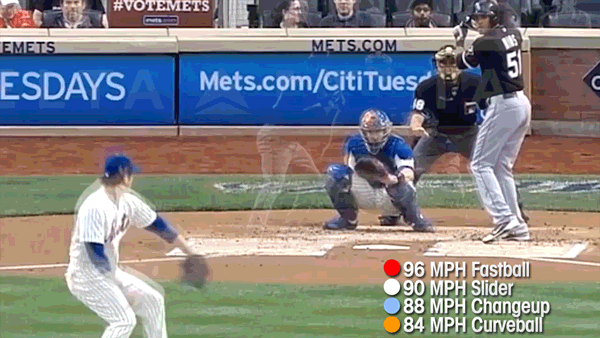
Matt Harvey's Release Point
...and how that contributed to his deceptiveness.
Those comments made it into the piece in the form of the graphic
below.
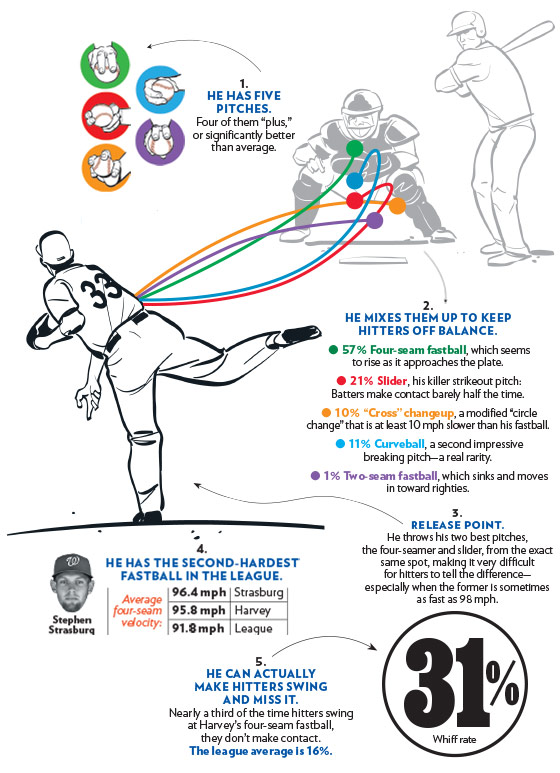
The Secrets of Matt Harvey's Success
During that interview, I also made some comments about Matt
Harvey's pitching mechanics that didn't make it into the piece.1
The gist of
what I said was
that, while I was very impressed with his performance to date,
I
had come across some pictures of Matt Harvey, and had in my
possession a number of video clips, that were a cause for some
concern.2
The explanation for what I was seeing, and why
Matt Harvey's pitching mechanics had changed, can be found later on
in that New York Magazine piece...
In college, Harvey had clean mechanics but could
rush his throwing motion. Since, he’s focused on
keeping his windup "long," extending his throwing
arm for as long as possible,
then letting the momentum of his body drag it forward. This
adds a couple of miles per hour to his fastball.3
By teaching him to extend his throwing arm for as long as
possible, they taught him to rush; to get, and to keep, his arm
disconnected from the forward motion of his body.
The quote in the New York Magazine piece implies that the
goal was to keep him from rushing. However...
- I never saw Matt Harvey exhibit a problem with rushing
before.
- I now see Matt Harvey exhibit a problem with
habitual rushing.
If anything, the changes to Matt Harvey's mechanics "worked"
not by fixing his problem with rushing but by making him more
consistent.
Matt Harvey now rushes with every pitch.
Unfortunately, while this trick undoubtedly worked —
Matt Harvey is throwing harder than he was in high school —
it also came with a cost, a cost that Matt Harvey is now going
to have to pay, and hopefully before his shoulder starts to wear
down.
The Power T
I don't know what Matt Harvey was taught and what cues were
used to develop his arm action. However, I have worked with kids
who have been taught something called the
Power T that looks very much like what Matt Harvey demonstrates
when he talks about his pitching mechanics and does when he
pitches.
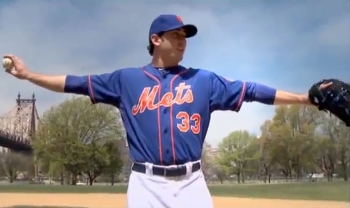
Matt Harvey
As I discuss at length in my in-progress
Inverted W webbook,
recent research into the Inverted W backs up something that
I came to realize a few years ago; the problem with the Inverted
W isn't the position itself, but the impact that position
has on the pitcher's timing.
Even though Matt Harvey doesn't have the glaringly
obvious Inverted W that Zack
Wheeler does, Matt Harvey does have the
Timing problem that is the real
problem with the
Inverted W.
Flat Arm Syndrome
I recently coined a new, and easy to look for term, to
describe what in 2012 alterted me to the problem with Matt
Harvey's pitching mechanics.
I call it
Flat Arm Syndrome.
Flat Arm Syndrome is just what it sounds like, a pitching arm
that is FLAT rather than UP at front foot plant.
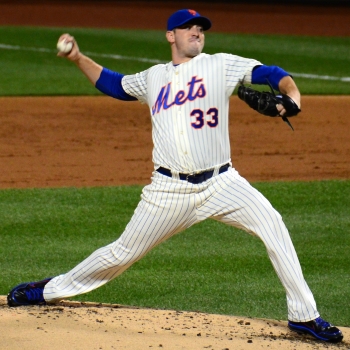
Matt Harvey
Technically speaking, Flat Arm Syndrome means 30 or fewer
degrees of external rotation of the pitching arm when the front
foot plants and/or the shoulders start to turn.
If I Ran the Zoo
So what would I tell Matt or Ed Harvey if they were to
contact me and ask me how they should deal with Matt's current predicament?
First, and like
Michael Pineda, Matt Harvey needs to immediately ditch the
things that he seems to have been taught about keeping his fingers on
top of the ball for as long as possible and, perhaps, showing
the ball to second base.
Second, if I were Matt Harvey, I would go back to the more
standard, Verlander-ian, Oswalt-ian, longer arm action that he used in high
school. A long arm
action isn't necessarily bad — Roy Oswalt's arm held up just
fine — but what Matt Harvey is currently doing isn't conducive to the longevity
of either the elbow or the shoulder.
After breaking his hands, Matt Harvey gets to the T Position
that all long armers do. However, the difference between what
Matt Harvey does and what Roy Oswalt does is that Roy Oswalt's
forearm is looser at the T Position.
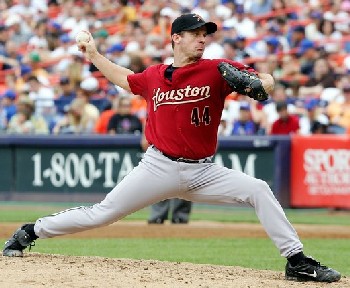
Roy Oswalt
That allows him to get his arm up to the proper position by
foot plant and keeps his arm from dragging.
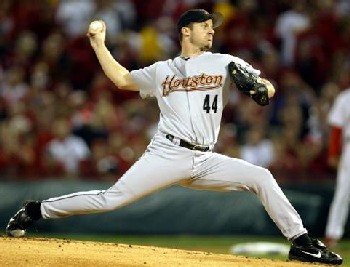
Roy Oswalt
In contrast, Matt Harvey pronates too soon and for too long,
showing the ball to center field and
second base. That creates the tension that causes his arm to stall and
IMO is the
major contributor to his elbow problems.

Matt Harvey
I know that increasing numbers of people teach what Matt
Harvey does — how he pronates early and shows the ball to
second base — but, while that may often give a pitcher a velocity
boost, it is problematic physiologically and is contributing
to the epidemic of elbow injuries of pitchers of all ages.
Also, and contrary to what the
Sports Illustrated article about Matt Harvey implies,
Roger Clemens most certainly did not
show the ball to second base. Heck he wasn't even a long-armer.
Instead, and like virtually every great right-handed pitcher,
Roger Clemens showed the ball to third base.

Roger Clemens
Given that his learning to show the ball to second base coincided with
the boost in his velocity, won't changing this cost Matt Harvey some
velocity?
Almost certainly.
However, the tear in Matt Harvey's UCL demonstrates that
his current pitching mechanics are putting a load on his
body that his elbow — and likely his shoulder — can't
tolerate.
That makes any concerns about the impact of a change to Matt
Harvey's pitching mechanics on his velocity a moot point.
Matt Harvey can't just keep doing what he's doing and expect to last.
What's more, I'm not convinced that Matt Harvey has to give
up all of his new-found velocity. I see a fairly common inefficiency in how
he uses his lower body that suggests that he has a few more
miles per hour in reserve and that he can develop with some hard
work.
Finally, Matt Harvey still needs to learn how to pitch. To a large
degree, his current approach is based on blowing people away
with his four-seam fastball. Given his exceptional
deception...

Matt Harvey's Release Point
...and his broad arsenal of plus pitches, Matt Harvey would
seem well-suited to backing off a few miles per hour and focus
on getting people out by locating his pitching and mixing up his
pitch selection.
That is the strategy that is used by most of the greatest
pitchers of all time, and is something that Matt Harvey still
has plenty of time to learn to do.
Matt Harvey didn't pitch when the Mets came through, so I
haven't been able to do a comparative video analysis, but I do
see some trends in the photographs I look at.
Perhaps Some Good News
I have yet to find a recent photograph showing anything close
to the
Flat Arm Syndrome that got Matt Harvey's elbow.

Matt Harvey 2012
Instead, he fairly consistently seems to be demonstrating a
better position at foot strike.
Having said that,
Matt Harvey's velocity
was up significantly toward the end of the 2015 regular season,
and you have to be concerned if that was being achieved by
reverting to the (problematic)
Timing pattern that got his elbow.
The (Lingering) Bad News
The problem is that I continue to see evidence of
Premature Pronation in Matt Harvey's pitching mechanics.
Notice the twist in the wrist of his pitching arm as he points
the ball at second base.
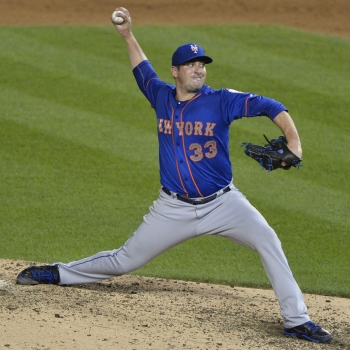
Matt Harvey 2015.7.20
That suggests that, while the risk to Matt Harvey's shoulder
has dropped (some), the ongoing risk to his elbow is no lower.
Notes
1. The interview was conducted over the phone, so I don't have a
transcript to prove what I said.
However, I did send a follow-up e-mail to the writer that said...
FYI, here are some pictures of Matt Harvey
that show the timing problem that I am talking about and
that concerns me.

Matt Harvey
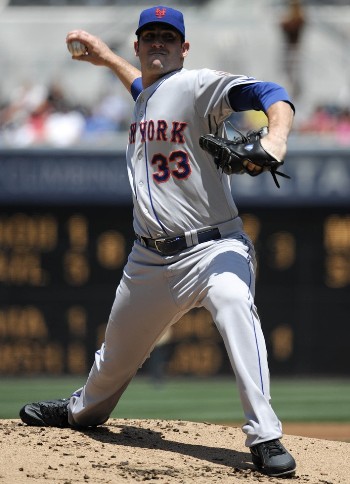
Matt Harvey
Given that his front foot is down, his pitching arm should be
more vertical.
However, those comments didn't make it into the piece.
2. I discussed my concerns about Matt
Harvey's pitching mechanics during
a phone interview on the Steve Czaban show on May 9, 2013.
My comments about Matt Harvey start at around 12:55 into the
interview. I also discussed my concerns about Matt Harvey's (and
Jose
Fernandez's and Lance Lynn's) pitching mechanics
on a Cardinals fan site
several days before Harvey started having elbow problems.
3. I recently came across a quote from
Baseball America from after the 2010 draft that indicated
that others noticed that Matt Harvey changed something in his
arm action...
Scouts agree that Harvey's arm action is longer now than it
was in 2007 but they aren't sure why. It affects his command, as
it's harder for him to repeat his delivery and find the same
release point. When he does, Harvey has explosive stuff, and he
has worked harder than ever, thanks to improved maturity, to
improve his balance and tempo.
|



 Matt Harvey's pitching mechanics are flawed and are putting his career
at risk; he needs to start saving his money because, if he doesn't
change anything — and, at this point, likely even if he does — the
end of his career is right around the corner.
Matt Harvey's pitching mechanics are flawed and are putting his career
at risk; he needs to start saving his money because, if he doesn't
change anything — and, at this point, likely even if he does — the
end of his career is right around the corner.














